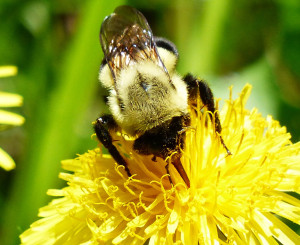Alarming link between fungicides and bee declines revealed

Bumble bee -Jennifer Howard photo
Fungicides are found to be the strongest factor linked to steep bumblebee declines, surprising scientists and adding to the threats to vital pollinators
By Damian Carrington The Guardian
Common fungicides are the strongest factor linked to steep declines in bumblebees across the US, according to the first landscape-scale analysis.
The surprising result has alarmed bee experts because fungicides are targeted at molds and mildews – not insects – but now appear to be a cause of major harm. How fungicides kill bees is now being studied, but is likely to be by making them more susceptible to the deadly nosema parasite or by exacerbating the toxicity of other pesticides.
The widespread decline in bees and other pollinators is worrying because they fertilise about 75% of all food crops, with half of pollination being done by wild species. Pesticides, habitat destruction, disease and climate change have all been implicated in bee declines, but relatively little research has been done on the complex question of which factors cause the most damage.
The new study, published in the journal Proceedings of the Royal Society B, used machine learning statistical methods to analyse the role of 24 different factors in explaining the decline of four bumblebee species, tracked at 284 sites across 40 US states. These included latitude, elevation, habitat type and damage, human population and pesticide use.
“The ‘winners’ in predicting both nosema prevalence and range contraction were fungicides,” said Scott McArt, at Cornell University in the US and who led the new study. In particular, chlorothalonil, the most used fungicide in the US, was most strongly linked to nosema, while the total fungicide usage was the best predictor of losses of bumblebees.
“I was definitely surprised,” he said. “Fungicides have been largely overlooked.” However, a few lab-based studies have shown that fungicides can make nosema much worse in bees, probably by killing beneficial gut microbes. “We are showing the same thing is happening at the larger scale as people are showing in the lab.”
advertisement
“There needs to be much more work on fungicides and their role in bee declines,” McArt said. “People are not looking in all the places they probably should.”
Matt Shardlow, at conservation charity Buglife, said: “The way we humans are managing the landscape is putting bees are under enormous pressure, and just as we seem to be making progress towards a complete ban [in the EU] on a proven factor – neonicotinoid insecticides – it appears a very common fungicide could also be a driver of wild bee declines. Scientists and regulators must respond with urgent new studies.” Chlorothalonil is the most used pesticide spray in the UK, used on 4.5m hectares of land in 2016.
“This research suggests the regulatory system for pesticides may have let us down once again, perhaps because regulatory tests don’t expose bees to the pesticide and a disease at the same time,” said Prof David Goulson, at the University of Sussex, UK. He said it also supported the argument made recently by a UK government chief scientific adviser that the landscape-scale effects of pesticides cannot be predicted from controlled lab and field studies.
Assumed safety of pesticide use is false, says top government scientist
Read more
The evidence showing the serious harm to bees caused by neonicotinoids, the world’s most widely used insecticides, is continuing to accumulate. New research shows the combination of neonicotinoids and reduced food supplies cut bee survival by 50%. “Interactions between the many threats to bees appear to increase the risk of pesticide use to our beneficial insects,” said Christopher Connolly, at the University of Dundee, UK.
Another study shows that neonicotinoids reduce the survival of bumblebee queens and the time it takes them to establish their nest, which is likely to harm the long-term survival of the colony. The European Commission is expected to vote on a total ban on neonicotinoids in fields in early 2018, with most nations – including the UK – known to be in favour.









Leave a Reply